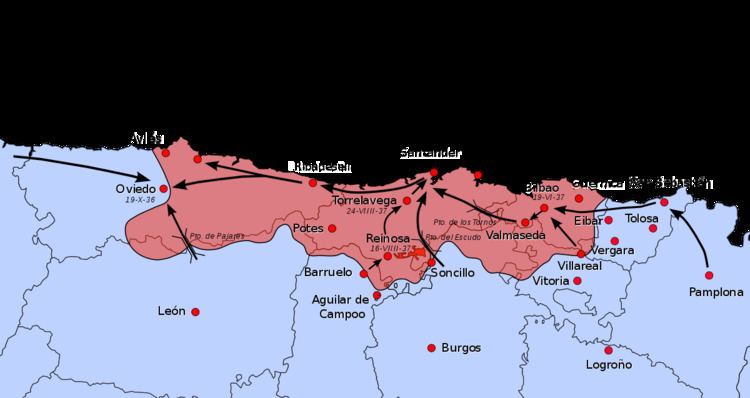Dates 1 Sep 1937 – 21 Oct 1937 | ||
 | ||
45,000180 artillery guns1 destroyer1 submarine 90,000250 artillery guns250 aircraft2 cruisers1 destroyer Result Decisive Nationalist victory Similar Biscay Campaign, Huesca Offensive, Battle of Mérida, Campaign of Gipuzkoa, Zaragoza Offensive | ||
The Asturias Offensive (Spanish: Ofensiva de Asturias) was an offensive in Asturias during the Spanish Civil War which lasted from 1 September to 21 October 1937. 45,000 men of the Spanish Republican Army met 90,000 men of the Nationalist forces.
Contents
Background
After the failed republican offensive against Zaragoza, the Nationalists decided to redeploy their forces and continued their offensive against the last piece of Republican held territory in the North, Asturias. On 29 August, the Sovereign Council of Asturias, led by Belarmino Tomas, assumed all military and civil powers and appointed Colonel Prada as commander of the Republican Army of the North.
Opposing forces
The Nationalists offensive was launched by the General Dávila's Army of the North, with 80,000 men. This force included the José Solchaga's four Navarrese brigades, the Aranda's three divisions and the Italian CTV. The Nationalists also had 250 cannons and 250 aircraft.
Opposing them, the Republicans had the Army of the North, led by the Colonel Prada, with the XIV Army Corps led by Francisco Galán (8,000–10,000 men) and the Colonel Linares's XVII Army corps (35,000). The Prada's chief of staff was Francisco Ciutat. The Republicans had 180 cannons, one squadron of Chatos and two flights of Moscas, around 35 aircraft.
The Nationalist Offensive
The Nationalist offensive started on 1 September, Solchaga advancing from the East and Aranda from the southwest, but despite their crushing numerical and air superiority their advance was painfully slow (less than a kilometre a day). The Republicans fought fiercely and the difficult terrain of the Cordillera Cantabrica provided excellent defensive positions. The Solchaga's troops (33,000 men) occupied Llanes on September 5 and attacked the El Mazuco pass, held by the CNT workers from La Felguera (5,000 men). The Navarrese managed to conquer the Pass, only after 33 days of bloody combats. On September 18 the Nationalists occupied Ribadesella, on 1 October Covadonga, but by 14 October, the Republicans still held several high passes of the Leonese Mountains.
The main goal of the Republicans was to delay the Nationalist advance until the winter came, nevertheless, then the Legion Condor returned from the Aragon front and started to bomb the Republican positions. The German squadrons used napalm (cans of petrol attached to incendiary bombs) and tested the idea of the carpet bombing. On 14 October Arriondas fell, and the Colonel Muñoz Grandes managed to break the republican front, entering in Tama and advancing to Campo de Caso. The Republican troops retreated to Gijón and on 15 October the Solchaga's troops joined up with Aranda's troops.
Then, the Republican government ordered to begin the general evacuation and on 17 October the Sovereign Council of Asturias decided to start the evacuation, but the Legion Condor sank the Republican destroyer Ciscar and the Nationalist fleet blocked the Asturian harbours. Only the senior officers managed to escape on gunboats and fishing vessels (Prada, Galán, Segundo Blanco, Belarmino Tomas). On 20 October, twenty-two Republican battalions surrendered and the Colonel José Franco, handed over the town of Trubia to the Nationalists. On October 21, the Nationalists entered Gijon, ending the occupation of Asturias. Nevertheless, thousands of Republican soldiers fled to the nearby mountains and started a guerrilla campaign against the Nationalist troops.
Aftermath
The Nationalist repression was harsh. In Oviedo alone, 1,000 republican prisoners were shot. The Republican prisoners were sent to labour battalions or were forced to join the Nationalist army (around 100,000). Furthermore, with the conquest of the North, the Nationalist controlled the 36 per cent of the Spanish industrial production, 60 per cent of the coal and all the steel production.
